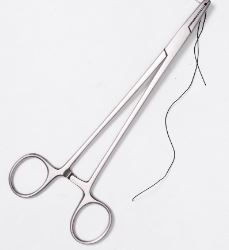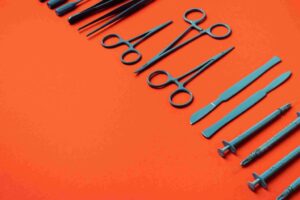In a world of surgical operations, accuracy and control remain top priorities. Doctors frequently utilize various custom tools to ensure the best results, including the most well-known, surgical needle holders. Needle holders are also called driver needles or needle forceps. These needle driver types are the instruments that, in addition, help surgeons to accomplish effective suturing and tissue adjustments during operations.
Apart from the facts as mentioned earlier, surgical needle holders and forceps also need to be designed in such a way that they can easily pick up and move the suture needles, so that the surgeons are able to put stitches at the point where they wanted with good precision. It cannot, however, be overstressed the worthiness of these tools, which in turn not only affect the recovery of the patient but also the healing of the wound itself.

The Critical Role of Needle Holders in Surgery: Types and Applications
The various needle holder types are such that they are made to suit individual surgical needs. The special characteristics of the instruments and their applications are problems that doctors from every part of the world have to decide. We will now look into some of the most popular sorts of needle holder instruments:
Mayo-Hegar Needle Holders
Super flexible Mayo-Hegar needle holders are typically applicable, in general, to surgical interventions. They are featured with a strong, serrated jaw that provides a good hold of needles that come in different dimensions. These needle holders are commonly used in abdominal surgeries and basic surgical procedures.
Castroviejo Needle Holders
Castroviejo needle holders, meant for surgeries that need delicate operation, are the perfect tool for eye and microsurgeries. They have very fine tips for precision and the attachment mechanism that ensures safe needle placement in such complex procedures.
Olsen-Hegar Needle Holders
Olsen-Hegar needle holders perform two functions: holding the needle and cutting, which helps a lot to increase the effectiveness of surgical treatments. This double-functioning feature of the instruments is a real plus. Such instruments are thought to be better for circumstances such as cutting a high number of surgical suture needle types during operations.
Barraquer and Mathieu Needle Holders
Such exceptional needle holder surgical instruments are exclusively designed for very particular operation cases. They possess different handling attributes. Yet, Barraquer needle holders are often utilized in ophthalmologic surgeries, and Mathieu needle holders are preferred in vascular and cardiovascular procedures.
Key Factors in Choosing the Right Surgical Needle Holders
Selecting the right kind of needle holder forceps is the most important thing in the course of the operation. There are several things that doctors have to keep in mind when choosing these instruments:
Procedure Type: The use of different types of needle drivers on different operations has always been a common practice. It is very important to have the right instrument for the actual surgical procedure. Operations such as microsurgeries may need the use of more delicate needle holders than general abdominal surgeries.
Material and Durability: Selecting types of needles in surgery, like stainless steel or tungsten carbide, can ensure long usage of the needle holders while offering excellent resistance to corrosion. They are the most corrosion-resistant materials, and even after many working cycles and cleaning and sterilization cycles, they still function perfectly.
Ergonomics and Comfort: Designs that have the feature of reducing hand fatigue during long procedures are the best choice for surgeons. With the help of ergonomically designed needle holders, many surgeons have noticed a great improvement in the way they operate the needle holders during extended surgeries.
| Feature | Hemostat | Needle Holder |
| Primary Function | Clamping and controlling blood vessels or tissues | Holding needles firmly during suturing with needle-type surgery |
| Jaw Design | Serrated jaws (often curved or straight) for gripping vessels | Shorter, sturdier jaws with crisscross serrations to hold needles securely |
| Structure | Generally, more delicate, long handles | Heavier build, with reinforced jaws |
| Locking Mechanism | Yes, ratchet-lock to clamp vessels | Yes, ratchet-lock to maintain a strong grip on the needle |
| Tungsten Carbide Inserts | Rare for a needle driver for suturing | Common, for better needle control and durability |
| Common Surgical Use | Hemostasis (stopping bleeding), tissue manipulation | Suturing (especially in deeper or difficult areas) |
| Examples | Mosquito Hemostat, Kelly Clamp | Mayo-Hegar, Olsen-Hegar, Castroviejo |
| Material | Stainless steel, basic finishes | High-grade stainless steel, often with carbide inserts |
| Grip & Ergonomics | Fine grip for gentle vessel handling | Firm grip is designed to withstand pressure from suturing |
| Typical Size Range | Longer sizes for deep tissue access | Shorter, controlled length for suturing precision |
Maintenance and the Right Care for Longevity
The correct care for needle holders for surgery is the major factor to ensure the durability and maximum efficiency of this equipment. We highlight the best ways to clean, sterilize, and store such instruments:
- Cleaning: Immediately after use, do not miss this critical step; wash the needle holders under a running water stream to take away all the visible impurities (under water). And don’t forget to comb the parts that are hard to reach with the soft brush. Moreover, the cleaning of the jaw and locking mechanism needs special consideration.
- Sterilization: The hospitals follow the protocol for sterilization, which mainly consists of autoclaving in general. But the important thing is that the needle holder must be 100% dry before the sterilization occurs to prevent corrosion.
- Storage: Needle holders should be stored in a dry, clean space. Try to store them in instrument trays or use protective cases to avoid damage while storing and carrying them.
- Inspection: Periodically inspect needle holders to find damage and bad alignment signs, and replace elements with those that have been out of order to keep the surgery accurate.
Conclusion: Investing in Quality for Surgical Success
Without a doubt, the decision on the right needle holders determines the success of the surgery. They are useful for the surgeons to take into account certain characteristics of the procedures applied, the compatibility with types of needles for surgery, and the instruments’ ergonomic design. Quality needle holders from brand names come with the backing of medical professionals to perform directed precision and self-assured procedures.
The progress of surgical procedures will also have an impact on the design and the nature of the needle holders. Keeping abreast of the most recent advances in the field of surgery instruments will make healthcare professionals better prepared for the purchase and choice of instruments, which are essential tools.
Improve your surgical skills today. Check Wrangler’s variety of the finest surgical needle holders that we have collected, so they can meet the various surgical needs. You can talk to our professionals to choose the best instruments for your needs and move your career into high gear in surgical practice.
FAQs
1. What is a needle holder?
A needle holder is an instrument in surgery that is used to grab and move the suture needles during surgical treatment. It enables the surgeon to operate with precision while suturing the tissues and wounds.
2. How do surgical needle types differ from hemostats?
While both items can sustain a solid grip, needle holders have the particular function of handling suture needles as they have serrated jaws and a locking mechanism. On the other hand, Hemostats are essential when it comes to clamping blood vessels and holding tissues together.
3. What are the most common types of needle surgery holders?
The most the types of surgical needles common kinds of needle holders are Mayo-Hegar, Castroviejo, Olsen-Hegar, and Mathieu. Every type of surgical needle is adapted to specific surgical applications, including general procedures and delicate microsurgeries.
4. What is a needle driver, and how to hold a needle driver?
For the proper execution, handle the needle driver right, hold it with the thumb and ring finger of the dominant hand in the rings, and the index finger should be placed on the shaft for better stability, and to be more controlled in the suture.
5. What materials are commonly used in manufacturing needle holders?
The top-quality needle holders are often made of stainless steel and/or tungsten carbide. The reasons for this are that they are the most durable material, resistant to rust, last long, and also, they stay in proper grip of a needle throughout the whole diagnostic procedure.




